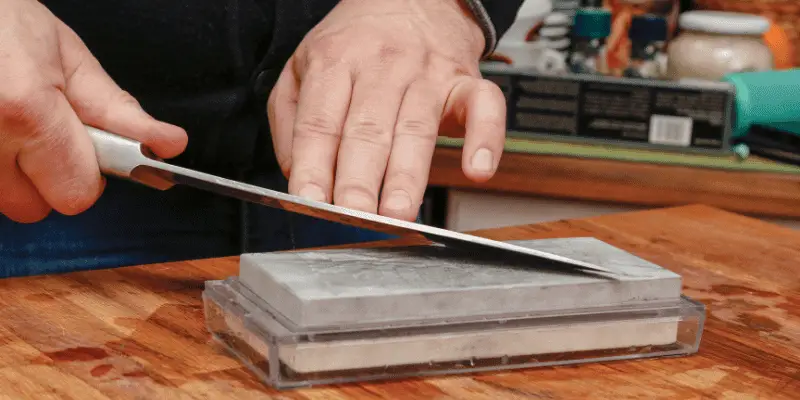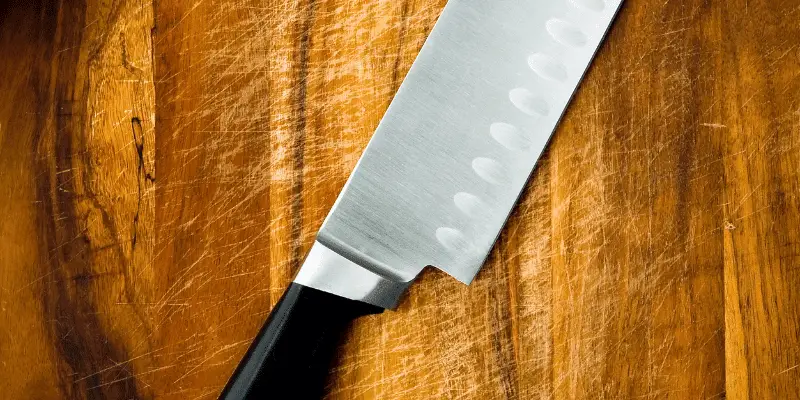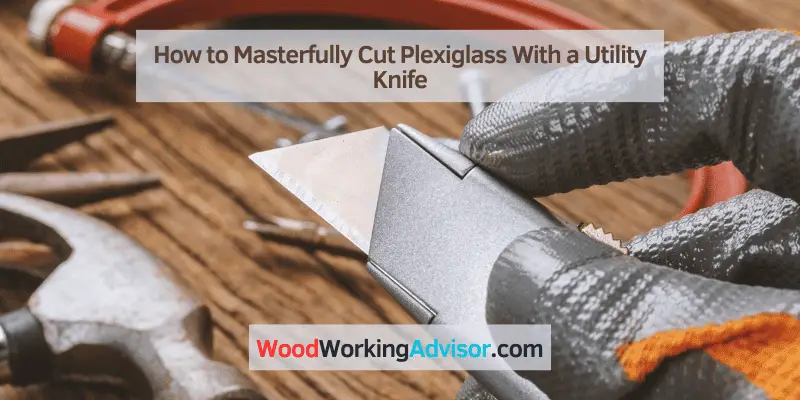To cut plexiglass with a utility knife, score along the cut line multiple times, apply pressure evenly, and snap the piece off. Plexiglass, also known as acrylic, is a versatile material used in various applications, from windows and signage to crafting projects.
While cutting plexiglass may seem daunting, it can be easily achieved with a utility knife. By following a few simple steps, you can cut plexiglass accurately and safely. This article will guide you on how to cut plexiglass with a utility knife using a scoring and snapping technique.
So, whether you are a DIY enthusiast or a professional, read on to learn how to effectively cut plexiglass and make precise cuts for your next project.
Tools And Materials Needed For Cutting Plexiglass
To cut plexiglass with a utility knife, you will need a few essential tools and materials: a utility knife with a sharp, retractable blade, a ruler or straight edge for precise measurements, a clamp to secure the plexiglass in place, and a cutting surface such as a piece of plywood or a cutting mat.
These tools will ensure a clean and accurate cut.
Cutting plexiglass can be a daunting task if you don’t have the right tools and materials. To ensure a smooth and safe cutting experience, it is essential to gather the following items:
Utility Knife
A utility knife is the main tool you’ll need to cut plexiglass efficiently. Opt for a knife with a sharp and retractable blade. Ensure the blade is firmly in place before starting the cutting process. A sturdy utility knife will provide you with the precision required for accurate cutting.
Safety Glasses
Protecting your eyes should always be a priority when working with any kind of material, especially plexiglass. Safety glasses act as a shield against flying debris and small particles, preventing potential eye injuries. Make sure to wear safety glasses that conform to safety standards and provide adequate coverage.
Measuring Tape
Accuracy is crucial when cutting plexiglass to meet specific dimensions. A measuring tape allows you to take precise measurements and mark the cutting lines accordingly. Before making any cuts, double-check your measurements to ensure they align with your intended dimensions.
Pencil
A pencil is an essential tool for marking the cutting lines on the plexiglass. It provides clear and visible lines that guide you during the cutting process. Use a sharpened pencil for precise measurements and markings. Remember to use gentle pressure to avoid scratching the plexiglass surface.
Straight Edge Or Ruler
A straight edge or ruler helps you maintain straight and accurate cutting lines. It acts as a guide for your utility knife, ensuring clean and even cuts. Ideally, choose a straight edge or ruler made of durable material, such as metal or acrylic, to prevent any flexing while cutting.
With these essential tools and materials in hand, you’ll be well-equipped to tackle the task of cutting plexiglass. Remember to prioritize safety by wearing protective gear and taking necessary precautions throughout the cutting process.
Preparing The Plexiglass For Cutting
Cutting plexiglass can seem like a daunting task, but with the right preparation, it can be a breeze. Before you pick up your utility knife, take the time to properly prepare the plexiglass for cutting. This will ensure clean and accurate cuts, without any unwanted cracks or damage. In this section, we will cover the essential steps to prepare the plexiglass surface, measure and mark the cutting line, and place the plexiglass on a stable surface.
Cleaning The Plexiglass Surface
Before cutting plexiglass, it is crucial to clean the surface to remove any dirt, dust, or debris. This will prevent any particles from interfering with the cutting process and help ensure a smooth and precise cut. Follow these simple steps to clean the plexiglass surface:
- Gently wipe the surface with a clean, lint-free cloth to remove any loose dirt or dust particles.
- Prepare a solution of mild dish soap and water in a container.
- Dip the cloth into the soapy water and wring out any excess liquid to avoid dripping.
- Wipe the plexiglass surface in a circular motion, ensuring to cover the entire area.
- Rinse the cloth with clean water and wipe off any remaining soap residue from the surface.
- Allow the plexiglass to air dry fully before proceeding to the next step.
Measuring And Marking The Cutting Line
Accurate measurements are crucial when cutting plexiglass to ensure it fits your desired application. Follow these steps to measure and mark the cutting line:
- Using a measuring tape or ruler, measure the length and width of the plexiglass piece you need.
- Use a pencil or a fine-point marker to make light marks on both sides of the plexiglass where the cuts will be made.
- Double-check your measurements and adjust if necessary.
- Connect the marked points on each side of the plexiglass with a straight-edge ruler to form a clear cutting line.
- Make sure to mark both sides of the plexiglass to ensure accuracy when cutting.
Placing The Plexiglass On A Stable Surface
Once you have cleaned the plexiglass and marked your cutting line, it’s time to position it on a stable surface. This will provide support and stability during the cutting process. Follow these steps to place the plexiglass on a stable surface:
- Choose a flat and sturdy surface, such as a workbench or table, that can accommodate the size of the plexiglass piece.
- Ensure the surface is clean and free from any obstructions or objects that may interfere with the cutting process.
- Lay a non-slip mat or a piece of scrap wood on the surface to prevent the plexiglass from sliding or scratching.
- Position the plexiglass on top of the non-slip surface, ensuring it aligns with the marked cutting line.
- Press down gently to secure the plexiglass in place.
Choosing The Right Utility Knife And Blade
When it comes to cutting plexiglass, using the right utility knife and blade is crucial for achieving clean and precise cuts. With a sharp knife and the correct blade, you can effortlessly glide through the material without any unwanted chipping or cracking. In this section, we will explore the key factors to consider when choosing a utility knife and blade for cutting plexiglass.
Selecting A Utility Knife With A Sharp Blade
A utility knife with a sharp blade is essential for cutting plexiglass effectively. The sharper the blade, the easier it will be to cut through the material smoothly. When selecting a utility knife, make sure to check the blade for any signs of dullness or damage. A dull blade can lead to rough edges and potential accidents. It is advisable to invest in a high-quality utility knife with replaceable blades, allowing you to easily swap out a dull blade for a sharp one.
Considering The Thickness Of The Plexiglass
The thickness of the plexiglass plays a significant role in determining the type of utility knife and blade required for cutting. Thicker plexiglass requires a sturdier and more durable blade that can withstand the pressure applied during cutting. Conversely, thinner plexiglass can be cut with a lighter-duty blade. Ensure that the utility knife and blade you choose are suitable for the thickness of the plexiglass you are working with to avoid any mishaps or damage to the material.
Using A Fine-toothed Blade For A Clean Cut
To achieve a clean and smooth cut on plexiglass, it is recommended to use a fine-toothed blade. The fine teeth on the blade help minimize chipping and produce a more precise finish. These blades generally have more teeth per inch (TPI) than standard blades, allowing for greater control and accuracy. When using a fine-toothed blade, be sure to maintain a steady hand and apply consistent pressure to avoid any unnecessary strain or cracks in the plexiglass.

Cutting Techniques For Plexiglass With A Utility Knife
Learn how to effectively cut plexiglass using a utility knife with these essential cutting techniques. Say goodbye to common errors and achieve clean, precise cuts every time.
When it comes to working with plexiglass, a strong and versatile material used in various projects, it is essential to have the right cutting techniques. Using a utility knife can be a cost-effective and efficient way to cut plexiglass. In this article, we will explore the step-by-step process of cutting plexiglass with a utility knife. By following these techniques, you can achieve clean and accurate cuts for your projects.
Scoring The Plexiglass Surface With A Knife
Scoring the plexiglass surface is the first step in cutting it with a utility knife. To begin, measure and mark the desired cutting line on the sheet of plexiglass. Next, use a straightedge to guide the utility knife along the marked line, applying firm downward pressure. The goal is to create a shallow groove or score along the cutting line.
Applying Pressure To The Scored Line
Once the plexiglass surface is scored, it’s time to apply pressure to the scored line. Position the sheet of plexiglass on a stable, flat surface, ensuring that the scored line aligns with the edge of the surface. With both hands, gently apply downward pressure along the scored line. Gradually increase the pressure, making sure to maintain a steady and even force.
Repeating The Scoring Process Multiple Times
In some cases, a single scoring might not be enough to cut through the entire thickness of the plexiglass. To ensure a clean cut, it may be necessary to repeat the scoring process multiple times. Align the utility knife with the scored line and repeat the scoring motion, applying firm pressure. Continue scoring the line until you can see a visible groove on both sides of the plexiglass.
Reducing The Pressure To Break The Plexiglass
Once the scoring is complete, it’s time to break the plexiglass along the scored line. To do this, reduce the pressure applied with the utility knife. Hold one side of the plexiglass firmly with one hand while applying a gentle bending force away from the scored line. With the other hand, apply slight pressure at the opposite side of the scored line. The plexiglass should snap cleanly along the scored line.
By following these cutting techniques, you can confidently cut plexiglass with a utility knife. Remember to wear safety goggles and work in a well-ventilated area when handling plexiglass. With the right techniques, you can achieve precise and professional-looking cuts for your projects.
Tips For Smooth And Accurate Cuts
If you want to achieve smooth and accurate cuts when working with plexiglass, there are several tips you should keep in mind. Whether you’re an experienced DIY enthusiast or a beginner, these tips will help you cut plexiglass with a utility knife like a pro. In this section, we’ll delve into three essential tips that will ensure your cuts are precise and clean.
Using A Straight Edge Or Ruler As A Cutting Guide
One effective way to improve the precision of your cuts is by using a straight edge or ruler as a cutting guide. This simple technique helps maintain a consistent cutting line and prevents the knife from deviating. Place the straight edge or ruler along the desired cutting line and firmly hold it in place. Make sure it extends beyond the section you wish to cut to provide adequate support.
Applying Steady And Even Pressure While Cutting
When cutting plexiglass with a utility knife, it’s crucial to apply steady and even pressure. Inadequate pressure may result in jagged cuts or the knife slipping, ruining your workpiece. Start by holding the utility knife firmly but not too tightly. Begin cutting with smooth motions, applying pressure gradually. Maintain a steady pace while ensuring each stroke is strong enough to penetrate the plexiglass without excessive force.
Taking Breaks To Avoid Overheating The Plexiglass
It’s important to remember that plexiglass can become hot during the cutting process due to friction. To prevent this, taking breaks at regular intervals is necessary. Allowing the plexiglass to cool down helps retain its structural integrity and prevents warping. Give the material a chance to cool after several passes or when you notice the plexiglass becoming warm to the touch. This step is particularly important when cutting thicker plexiglass sheets.
Making Multiple Passes For Thicker Plexiglass
For thicker plexiglass sheets, it’s often necessary to make multiple passes to achieve a clean cut. Trying to cut through thicker plexiglass in a single stroke can lead to a rough finish or even damage the material. Begin by making a shallow scoring cut along the desired line. Then, repeat the process, gradually increasing the depth of each pass until you cut through the entire sheet. Take your time and let the utility knife do the work for smoother results.
In conclusion, these tips will help you achieve smooth and accurate cuts when working with plexiglass. By using a straight edge or ruler as a cutting guide, applying steady and even pressure, taking breaks to avoid overheating, and making multiple passes for thicker sheets, you’ll be able to create precise and clean cuts with a utility knife. Remember to always prioritize safety and take your time to ensure the best results.

Safety Precautions And Clean-up
When it comes to cutting plexiglass with a utility knife, safety precautions and clean-up are crucial steps to follow. Taking the necessary measures to protect yourself and properly cleaning up after the cutting process ensures a safe and efficient experience. In this section, we will explore the three important aspects of safety precautions and clean-up when cutting plexiglass with a utility knife: wearing safety glasses to protect your eyes, using clamps to secure the plexiglass, and cleaning up the cut pieces and debris properly.
Wearing Safety Glasses To Protect Your Eyes
Protecting your eyes is of utmost importance when working with any kind of glass material, including plexiglass. Flying debris or shards can potentially cause serious eye injuries. To safeguard your eyes, make sure to wear safety glasses before you begin cutting.
Remember, accidents can happen even when taking precautions, thus wearing safety glasses will provide an extra layer of protection. Whether you are a professional or a DIY enthusiast, never underestimate the importance of protecting your eyes when working with plexiglass.
Using Clamps To Secure The Plexiglass
Securing the plexiglass in place is essential to ensure a clean and accurate cut. Using clamps will not only provide stability but also prevent the plexiglass from shifting or moving during the cutting process.
Before you start cutting, position the plexiglass on a flat and stable surface. Place clamps along the edges to firmly hold the plexiglass in place. Make sure the clamps are tightened enough to prevent any movement but not too tight to damage the surface of the plexiglass.
This simple step of using clamps will not only improve your precision but also minimize the risk of accidents caused by the plexiglass shifting unexpectedly.
Cleaning Up The Cut Pieces And Debris
Properly cleaning up the cut pieces and debris is important for both your safety and the aesthetics of the project. Leaving behind small fragments or particles can pose a risk of injury, especially if someone accidentally steps on them.
To effectively clean up the cut pieces and debris, follow these steps:
- Start by gently removing the clamps and clearing the remaining plexiglass from the cutting surface.
- Use a broom or vacuum cleaner with a brush attachment to sweep or suction any loose fragments or dust.
- Dispose of the plexiglass scraps and debris properly, following local waste disposal regulations or recycling guidelines.
- Lastly, wipe down the cutting surface with a damp cloth to remove any remaining residue.
By ensuring a thorough clean-up, you not only maintain a safe working environment but also prevent any unwanted accidents or injuries caused by stray fragments.
Frequently Asked Questions For How To Cut Plexiglass With A Utility Knife
Can I Cut Plexiglass With A Utility Knife?
Yes, you can cut plexiglass with a utility knife. However, it is important to use the right technique and safety precautions to avoid cracking or breaking the plexiglass. Make sure to score the surface multiple times before gently snapping it along the scored line.
What Is The Best Way To Cut Plexiglass With A Utility Knife?
To cut plexiglass with a utility knife, first, mark your desired cut line using a ruler and a permanent marker. Then, score the marked line several times using a utility knife, applying firm, even pressure. Finally, gently snap the plexiglass along the scored line.
Sand the edges for a smooth finish.
Are There Any Safety Precautions When Cutting Plexiglass With A Utility Knife?
Yes, when cutting plexiglass with a utility knife, it is important to take certain safety precautions. Wear protective gloves and safety glasses to protect your hands and eyes. Use a workbench or cutting mat to ensure stability. Avoid putting excessive pressure on the knife to prevent accidents or damage to the plexiglass.
Can I Use A Regular Knife To Cut Plexiglass?
While it is possible to use a regular knife to cut plexiglass, it is not recommended. A utility knife is specifically designed for this purpose and provides better control and precision. Using a regular knife may result in uneven cuts, cracks, or breakage of the plexiglass.
Conclusion
To conclude, cutting Plexiglass with a utility knife can be a practical and cost-effective solution for DIY enthusiasts. By following the step-by-step guide mentioned above and taking safety precautions, you can achieve clean and precise cuts in Plexiglass. Remember to choose the right utility knife and use a scoring technique for better results.
With some practice and patience, you’ll be able to handle Plexiglass cutting projects with ease. So, grab your utility knife and get ready to take on your next DIY project!


